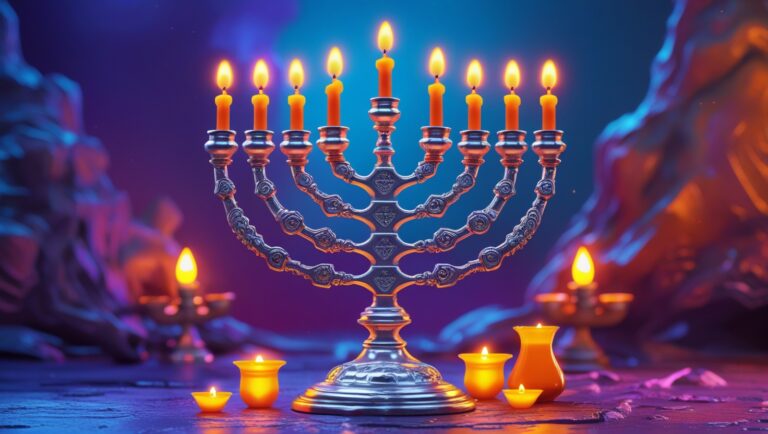Sefer Sha’arei Kedusha teaches us that anger and arrogance are the two most despicable Middot for a person to have and they both derive from the fire element
I often get the impression people think Mussar and Halacha are disconnected from Kabbalah. The truth is we don’t work on ourselves in order to just “be nice”. Sure, it’s great to be a mentsch (a good person) but going deeper, we find that having good Middot opens our perception to Hashem. Rabbi Chaim Vital spends a great deal of pages in the entire Kitvei Ari to teach how to have visions, dreams, Ruach HaKodesh and reach the ultimate wisdom.
Tikkun HaMiddot (rectification of character traits) is then the first stepping stone to these gifts especially when it comes to how to study Kabbalah. However, one doesn’t need to reach the level of Yosef HaTzaddik for that.
Sha’arei Kedusha gives us a fascinating overview of all Middot (character traits) and the elements (Yesodot, translated as “foundations”) they correspond to, as well as what one should do to rectify them to open one’s mind to receive the downflow of Hashem’s light. Self-perfection might well be impossible in this world, but that doesn’t mean we should give up as the entirety of Avodat Hashem depends on it.
Let’s explore a little bit the fire element and its effect on Middot but first, let’s learn a little Sha’arei Kedusha because this is one of the best Mussar books in my opinion.
The body of man and the 4 elements from Sha’arei Kedusha
Here’s a little introduction to how our bodies are made by the 4 elements:
Behold, when he [Adam HaRishon] sinned with the tree of knowledge of good and evil, he caused this mixing in all of the worlds and there is nothing which does not contain good and evil. Therefore, the body of a man is formed from the 4 lower foundations, behold they contain good and evil. And the body of a man is formed from the good of the 4 foundations – earth, water, wind, and fire.
However from the evil of them (the physical of the 4 elements,) were formed [in the body] 4 Maros (bitter substances, biles,) which are – white, black, red, and green. And when in any one of these [Maros], the evil in it strengthens over the good in it, sicknesses and afflictions come on a man. And if it strengthens itself greatly it will kill one’s body.
It’s important to note that these are not the physical elements, but spiritual ones. While I didn’t bring it here, the source of all these 4 elements is called Hyule (I think the translation would be “aether”). Either way, we are all a composite of them, in different proportions and they make all matter, including the human body. Throughout life, there is a giving and receiving between us and the 4 elements and they make up the Middot we carry.
I bring here another very powerful excerpt from Rabbi Chaim Vital‘s words when he explains the Middot that come from the fire element:
The Foundation [Element] of Fire embodies a sense of arrogance referred to as “Gasut HaRuach” (inflated spirit), distinguishing itself as the lightest and loftiest among all foundations. Within this essence resides anger, as arrogance often fuels frustration when one’s desires are thwarted.
Conversely, a person with a “shefal ruach” (humble spirit), acknowledging their deficiencies, is less prone to anger. Hence, it becomes evident that anger and arrogance are intertwined traits, manifesting as a unified characteristic. Three notable derivatives emerge from this union:
- Kapdanut (pedantry) within the depths of the heart. This internal irritability stems from arrogance, much like the connection elucidated between arrogance and anger.
- The pursuit of power and honor for ostentatious display. Seeking validation through the demonstration of power and honor is a direct offshoot of arrogance.
- Hostility towards others due to their perceived superiority, rooted in arrogance. The disdain for those deemed greater is, in essence, an extension of arrogant tendencies.
It’s interesting to note that arrogance is the source of anger, because, as Rabbi Chaim Vital explains, only an arrogant person can be angry because “his will was not done. All other subcategories of Fire, including anger, kapdanut (pedantry), and desire for honor derive from it.
The Baal Shem Tov used to say “imagine how much Torah one must study, how many fasts one must perform, how much self-mortification (sigufim) he must suffer, how much prayer one needs to be able to see Eliyahu HaNavi. Then imagine how much more one needs to do to merit that he replies to your greetings. Then, imagine how much everything could be lost in an instant (!) because the person might entertain the thought that he’s better than others!”
Deeper understanding on anger
Anger is such a bad trait that the Rambam writes it must be purged completely from one’s life (together with arrogance). In Sha’arei Kedusha, Rabbi Chaim Vital writes that even anger for a Mitzvah or a holy reason is bad.
In a sense, most of us consider ourselves to be objective but that is seldom the case. Many of our perceptions are merely constructs of what is true or false but not what is fully, objectively true or false. This is one of the reasons why Hitbodedut is so crucial to break that illusion. Only Hashem can help us dispel these impurities of thoughts.
Of course, when it comes to pointing out other people’s mistakes, we are the first to sternly display our aversion, but when it comes to acknowledging their mistakes, then we are better than any lawyer at defending ourselves.
The leaders of the Mussar (self-discipline) movement explained that people are generally incapable of seeing their own faults. That’s why we have others to see one of our faults that are projected into them and revealed to us. In essence, what we see wrong in others is precisely what we need to fix in us.
The Jewish sages state that there’s no such a thing in the world that’s completely, entirely bad, except for Amalek. This is because, every person or object, down to the most minute electron is imbued with a spark of divinity that requires it to exist. Without that spark, not a single thing in the world can exist and free will would also cease.
All situations come from Hashem and everything is custom-tailored for us to reach our Tikkun (rectification). So, when we are angry, we are essentially blind to the goodness that exists in that particular situation and, as the sages say, “it’s as if he commits idol worshipping”.
The inner and outer reality
Everything has an inner and outer aspect. The Zohar speaks about the stories and laws of Torah, which are its outer aspect, while the wisdom of Kabbalah is its inner aspect.
While we never discard the revealed Torah, for everything else, much like an orange’s peel is discarded so the fruit can be enjoyed, outer evil also can (sometimes) be discarded in order for the good to be enjoyed. It’s not that the outer aspect is inherently bad. However, when we dismiss the interior, then things turn sour altogether.
It’s like a painting whose frame (the external aspect) is more beautiful than the painting itself (the interior aspect). If someone were to compliment a work of art based on the frame, we’d think that’s a joke (because it is ridiculous).
The same is true when someone is complemented on his/her looks. This is not what most people look to be praised for. Rather, we carve that our souls (the inner aspect) should be great in other people’s eyes (our ideas, discipline, feelings, behavior and so on).
Ramchal’s Sefer HaKlalim
One way of understanding free will and the necessity to fight with the evil inclination (especially anger and arrogance) is through Ramchal’s Sefer HaKlalim (Klalot Sharshei HaChachma). In it, the concept of the Wisdom of Truth, also known as genuine Kabbalah, revolves around unraveling acts of Hashem and their systematic order as orchestrated with His creations.
The Ramchal (Rabbi Moshe Chaim Luzzatto) defines the Wisdom of Truth as: “The wisdom that explains the order of the acts of G-d, through which He acted and acts on His creations.
The book delves into Hashem’s overarching intent in creation, aiming to bring forth a creature, specifically mankind, capable of receiving divine goodness through merit. To facilitate merit, the existence of choices was paramount, leading to the establishment of a framework of actions that the created being could choose to undertake. This ensured that, by making the right choices, the creature would merit the ultimate goodness, which is reserved in Olam HaBah (world to come).
As the Ramchal puts it:
“God’s intent in creation was to create a creation (man) capable of receiving good from Him by meriting it. In order for merit to be possible, it was necessary for there to exist a matter which this creature can choose to do, so that when it does the matter, it will merit the good.”
The meticulous organization of the entire sequence of God’s creative acts was intended to ensure that the resulting Creation would orderly follow the choices made by humans, both individually as well as communally.
The text continues:
“He willed and conceived a type of creation (man) built from many synthesized parts, whereby the acts which perpetuate His creations would follow the matter and order of these parts.”
Hashem designed the creation to include both a good inclination and an evil inclination, setting the stage for the existence of free will and the ability to merit rewards through the divine act’s stages. The text explains:
“[And that this would be] in the way necessary in order for it to merit to receive the reward through the degrees of this act.”
As part of this grand design, God initiated the ordering of His acts, with each emanation of His simple light termed a “luminary” or “Sephira.” The quantity of these luminaries corresponded to the intricate details of the parts comprising the planned creation.
“Then according to this design, He started to order His acts. And each spreading out of His simple light to act is called ‘one luminary’ or ‘one sefira. Hence, of all these luminaries, there is not one which does not have a part in the body of man, and there is no limb in man which is not in the luminaries.”
From Sha’arei Kedusha we also learn that a person will be judged not only for the Mitzvot he did or did not do, but also for the Middot he rectified or not. According to Rabbi Chaim Vital, one who rectifies his Middot can easily perform all the Mitzvot and Torah study he has to do. Because it’s really only the Middot that weigh us down.
Using the fire element for good
Passion and love are also from the fire element and must be used for Avodat Hashem. The sages in Massechet Sotah 5 teach “Rabbi Chiya bar Ashi in the name of Rav states that a Talmid Chacham must have one-eighth of an eighth of arrogance.” This is shocking, but considering that without any arrogance at all, we’d cease to exist because we’d be nullified in Ein Sof and that without it, the Torah would be chas v’shalom dishonored (as people would disdain the sages), it is understandable.
This discussion might prompt us to ask another question: how can there be a Mitzvah to eradicate Amalek if that could cause Jews to hate?
Well, the Torah states that Amalek is the paradigm of evil on earth. As such, they are to be completely eradicated. This is because, if not destroyed, it can easily corrupt everything else bringing death and anarchy everywhere.
The Jewish soldiers of old, especially those in the desert, were generally Tzaddikim of the highest calibre and this is why they were able to perform the Mitzvah of Isha Yefat Toar: As Rabbi Chaim Vital explains in Sefer HaLikutim, the soldiers desired to uplift the spark of holiness that existed in them and never really saw anything else besides that. This was, in fact, Zimri’s intent with the Midianite princess Kozbi.
So, anger and arrogance really had no place even in a truly Jewish Army when people were most susceptible to these traits when performing their duties.
Though the Torah commands Jews to destroy Amalek (now we do this only with our own “internal Amalek”), it never commands us to be angry or arrogant. For real Tzaddikim, even war is seen as a battle that must first and foremost be won internally.
May Hashem help us merit to reach these lofty levels and purge anger and arrogance from us.







